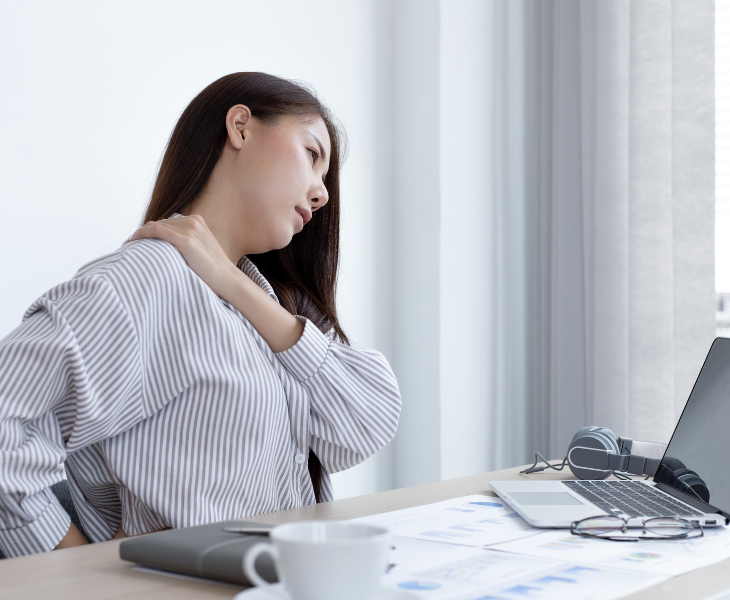First up, what is ergonomics?
Ergonomics and human factors is the science of designing the office or working space to suit the needs of employees. Office ergonomics is vital for maintaining the physical health and wellbeing of workers, ultimately benefitting the business in the process. Office ergonomics include chair and desk positioning, monitor positioning, and lifting methods. Poor ergonomics can lead to a multitude of long-term health risks, which can ultimately lead to permanent injury and an earlier death.
The word ergonomics comes from the Greek word ergon meaning ‘work’ and nomoi meaning ‘natural laws’, and can actually be traced all the way back to ancient Greece 2500 years ago, where there is written evidence that ergonomics was used in the design of their workplaces. Ergonomics is essential from the office to the factory, and is even applied as an important feature in space craft design! In the modern office, the main focus is on human-computer interaction and workstation product design.
Are you sitting down at your desk all day?

People are sitting down all day more than ever before in history. In the year 1900, almost half of the US workforce worked in the agricultural industry. But fast forward to one hundred years later, and this number dropped to 1.9%. By the year 2013, most people are working in office jobs, so 86 percentage of all full time workers in the US sit down all day long – despite the fact that nearly 70% really hate doing it!
Sitting is the new smoking – sitting all day is linked to a long list of very scary and very real dangers to your health. These include repetitive; strain injury, sprains, strains, tears, back pain, carpal tunnel syndrome, arthritis, hernias, chronic pain, and metabolic syndrome (heart disease, obesity, and high blood pressure). In fact, research from the American Cancer Society associated sitting down more than 6 hours a day with a 19% higher rate of death.
In a 2002 study of 60 people working at a Sydney call centre, it was found that 70 per cent claimed to have aches and pains from poor ergonomics, and didn’t report it. This means that most people are suffering from injuries related to poor ergonomics – and they think that it’s normal! Ignoring aches and pains can have big consequences. In fact, ergonomic-related injuries are the most prevalent form of injury in the workplace, accounting for a third of all workplace injury cases.
Still think it’s fine to slouch in your chair for 8 hours a day, 5 days a week? Think again! But it’s not too late to sit up straight. These injuries don’t happen overnight – they take a long time to manifest. Gradual exposure to ergonomic risks over a long period is what does damage to your health. That’s why the science of ergonomics exists – to protect you from these kinds of desk-and-chair-related dangers.
How does ergonomics affect businesses?
It’s not just health that benefits from good office ergonomics, it’s also the bottom dollar. Ergonomic-related injuries cost US businesses a staggering $15-20 billion annually in workers compensation. Employers need to protect their staff health and safety in order to maintain a productive work environment. Focusing on proper office ergonomics means employees will want to come to work every day and perform well. By being safe and comfortable, workplaces will have higher productivity and efficiency, and businesses won’t lose money on extra sick days or workers compensation.
Here’s our guide to the science of office ergonomics for the modern workplace!
How to protect your employees

1. Identify ergonomic risks
Your workstation, equipment, posture, and break habits are the main risk factors here. The theory is called “Four Points of Contact”. Ergonomists developed this system to protect your health: eyes to the source, hands to input devices, feet to the floor, and the body to the chair.
2. Set up the workstation
You will need the right equipment to protect yourself from ergonomic hazards:
- Chair
- Desk
- Keyboard
- Monitor
- Wrist rest
- Foot rest
3. Angles angles angles!

- Your elbows should be at a right angle when typing, with wrists straight and forearms supported
- Your head should be horizontal and aligned with the spine, with your screen one arms length away from you
- Don’t slouch! Spine should be straight with lower back supported
- Your hips, knees and ankles should be at an angle of slightly more than 90°
- Knees should be at or below the hips
- Feet should be flat on the floor or on a foot rest, ankles in front of the knees
- Shoulders should be low and relaxed
4. Take frequent breaks
Take frequent breaks to stretch, or go for a short walk and drink a glass of water. Experts recommend taking a 5-minute break every 60-90 minutes, as well as a 30-60 minute lunch break. Every 20 minutes, rest your eyes by looking at something 6 metres away for 20 seconds
5. Stretch often
Stretch often to avoid work-related injuries. Here are some easy stretching exercises you can do at your desk:

- Triceps stretch – raise your arms above your head, hold one elbow with the opposite hand and pull it toward your head. Hold for 10-30 seconds, and repeat on opposite side.
- Upper body arm stretch – clasp hands together above the head with palms facing upwards. Push arms upward, stretch for 10-30 seconds.
- Pectoralis stretch – clasp hands behind your back, push chest outwards, raise chin. Hold for 10-30 seconds.
- Torso stretch – feet placed firmly on the ground, twist upper body to rest one arm on the back of chair. Twist and hold for 10-30 seconds, repeat on other side.

